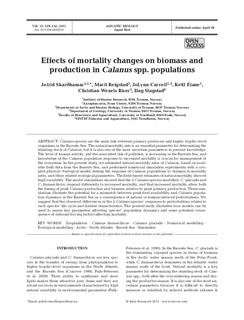Effects of mortality changes on biomass and production in Calanus spp. populations
Skardhamar, Jofrid; Reigstad, Marit; Carroll, JoLynn; Eiane, Ketil; Wexels Riser, Christian; Slagstad, Dag
Journal article, Peer reviewed

Åpne
Permanent lenke
http://hdl.handle.net/11250/293062Utgivelsesdato
2011Metadata
Vis full innførselSamlinger
Originalversjon
Skardhamar, J., Reigstad, M., Carroll, J., Eiane, K., Wexels Riser, C. & Slagstad, D. (2011). Effects of mortality changes on biomass and production in Calanus spp. populations. Aquatic Biology, 12(2), 129-145. doi: 10.3354/ab00321Sammendrag
Calanus species are the main link between primary producers and higher trophic-level organisms in the Barents Sea. The natural mortality rate is an essential parameter for determining the standing stock of Calanus, but it is also one of the most uncertain parameters in present knowledge. The level of human activity, and the associated risk of pollution, is increasing in the Barents Sea, and knowledge of the Calanus population response to increased mortality is crucial for management of the ecosystem. In the present study, we estimated natural mortality rates of Calanus, based on available field data from the Barents Sea, and performed numerical simulation experiments with a coupled physical-biological model, testing the response of Calanus populations to changes in mortality rates, and other related ecological parameters. The field-based estimates of natural mortality showed high variability. The model simulations showed that the 2 Calanus species modelled, C. glacialis and C. finmarchicus, respond differently to increased mortality, and that in creased mortality alters both the timing of peak Calanus production and biomass relative to peak primary production. These simulations illustrate the potential for a mismatch between peak food availability and Calanus population dynamics in the Barents Sea as a consequence of natural or human-induced perturbations. We suggest that the observed differences in the 2 Calanus species' responses to perturbations relates to each species' life cycle and habitat characteristics. The present study illustrates how models can be used to assess key parameters affecting species' population dynamics and some potential consequence of external forcing factors affecting mortality.
